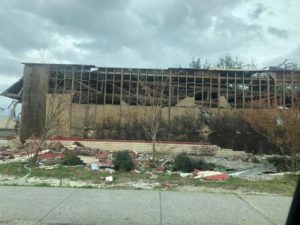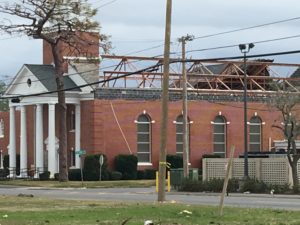Insured losses now at $5.6 billion

A disaster relief truck in Florida’s Panhandle, January 12, 2019
More pieces are starting to emerge toward building a comprehensive plan to address Hurricane Michael recovery, four months after the Category 4 storm struck Florida’s Panhandle. Besides the 43 lives lost in Florida and rising insurance claims, there’s been tremendous uncertainty and unmet needs in debris cleanup, housing, and recovery coordination.
Members of the Florida House of Representatives have collectively filed 452 bills, amounting to just over $1 billion in various recovery and rebuilding projects. Among them, 43 bills alone by Rep. Jay Trumbull (R-Panama City) worth $279 million. Rep. Trumbull’s proposals in part come out of meetings that he, Sen. George Gainer (R-Panama City), and U.S. Rep. Neal Dunn (R-FL 2nd Dist.) had last month with mayors from throughout the 14 impacted counties. Gainer often describes Hurricane Michael as the “granddaddy of all storms” that will require the “granddaddy of all legislation.” (He’s right: Michael was the third strongest Atlantic Hurricane to make landfall in the U.S.)
Among the biggest needs identified by struggling local governments: reimbursement for debris removal; access to loans (Bay County had the wherewithal to float a $50 million bond last fall for cleanup & initial infrastructure rebuilding); housing; additional sales taxing ability (in the case of Bay County, a proposed half-cent); and damage to roads and culverts. State and local agencies have cleared more than 26 million cubic yards of debris, but there’s much more to be cleared.

One of the many buildings damaged in Hurricane Michael, January 12, 2019
Rep. Trumbull’s bills focus on school reconstruction, a new water main between Panama City and Panama City Beach and other infrastructure, and beach restoration for Mexico Beach, ground zero for the 115 mph hurricane.
The proposed House spending measures are in addition to Governor DeSantis’ proposed $1.7 billion in his budget request and an expected $1.9 billion from the federal government. The Florida Senate has proposed allotting up to $50 million a year from the state Land Acquisition Trust Fund, which is funded by real estate doc stamp taxes for land and water conservation. Another Senate measure would pull $100 million from the BP Oil Spill recovery fund. Members of the board overseeing that fund have tentatively agreed to create a $15 million hurricane recovery fund.
As of last week, FEMA has provided more than $935 million in federal funding in grants, loans and flood insurance payments. Nearly 21,000 homeowners and renters have received financial rental assistance. In Bay County, there are still 274 displaced families living in condos or hotels in Panama City Beach. The county is asking FEMA to extend the program beyond the April deadline, noting there is no housing available east of the Hathaway Bridge, which separates Panama City Beach from Panama City.

Hurricane Michael’s Category 4 winds ripped off the roof of Panama CIty’s First Presbyterian Church, January 12, 2019
Gulf Power took a wallop from Michael as well. The storm caused massive damage to the utility’s distribution system leaving 136,000 customers without power after the storm. The utility has asked state regulators to approve a plan to pass along $342 million in rebuilding costs to customers over a five-year period.
Insurance losses continue to mount, at a pace of about 10% each month. The latest figures have estimated insured losses at $5.6 billion with 76.5% of claims closed (of those, 84% were paid and 15% unpaid). With 24% of claims still open (nearly 34,000), those losses have a long way to go. Artemis reports the marketplace expects the final insurance bill to be about $10 billion. Compare that to Hurricane Irma’s Florida losses of $11.1 billion as of last November with 7% of claims still outstanding.
The Tallahassee Democrat recently published “Hurricane Highway”, a terrific account of the struggling recovery, to add to its interactive Trajectory of Tragedy visual series on Hurricane Michael’s destruction across the Panhandle region. We recommend both.
LMA Newsletter of 2-18-19

